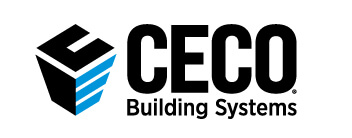Safe Snow Removal for Metal Roofing
Posted on February 14, 2018 by Ceco Building SystemsWinter brings snow to many places, and sometimes a lot of it. While skiers and school children may rejoice, those tasked with maintaining metal-roofed buildings may wonder what is the best action to take. Fortunately, the Metal Building Manufacturers Association (MBMA) offers some advice in the Metal Building Systems Manual.
How much is too much?
When a metal roof undergoes a structural engineering design, it necessarily takes into account the code-required levels of snow accumulation for the building location. At the low end, that might be on the order of 10-20 pounds per square foot (psf). However, on the high end it could be over 40 pounds per square foot. How does that translate into inches of snow? This does not translate easily as snow can vary wildly in density from being light and fluffy to wet and heavy. The MBMA suggests that something less than 5 pounds per square foot per inch of depth for very wet or heavy snow is a conservative estimate. Of course, that means if the roof is designed for a snow load of 20 psf, then any buildup over 4-5 inches might start to be a structural concern. Consultation with a structural engineer on the carrying capacity of the building and a reasonable range of snow density and weight can provide insights for a specific building.
High Slope versus Low Slope
Roof pitch makes a notable difference in all aspects of snow buildup on a roof. A high slope roof (i.e., more than 4:12) can experience conditions where some or all of the snow slides off of the roof. This can happen particularly when the sun is out or if heat loss from the building creates a water layer under the snow. By contrast, a low slope roof (i.e., less than 4:12) will not typically see the same sort of snow sliding, meaning it is more likely to build up and accumulate over time, typically getting icier and denser as it does so. This is a concern across the surface of the general roofing area, but it is a particular concern anywhere there is a change in height or where a vertical surface is encountered, such as a parapet wall, chimney, equipment, etc. In these locations, windblown snowdrifts can become trapped, so instead of blowing off of the roof, they accumulate in these areas, creating concentrations of heavier than planned dead weight. The accumulated snow can also find its way above flashings, and its thawing and freezing can eventually cause water leaks into the building.
Clearing Snow while Avoiding Roof Damage
The MBMA makes it clear that if excessive snow builds up on a metal roof, the best thing to do is remove some of the snow in order to ensure the loads are at safer levels. Also to ensure product quality, the MBMA stresses that removing snow carelessly or with any form of metal or sharp tools is not the recommended approach. Such an approach may cause serious roof damage to occur. Instead, they recommend a systematic approach that focuses on removing the excess snow only, leaving an acceptable, thinner layer on the roof to melt and disperse on its own. They also emphasize the importance of removing it uniformly from the entire surface of the roof, starting in the areas of accumulated snowdrifts, and then moving evenly across the roof from there. The MBMA also makes a point to note that piling snow from one place on the roof to another, even in small areas, is clearly counterproductive and can cause structural problems.
Keeping People Safe
Anyone going up onto a roof even in the best conditions needs to follow proper safety procedures, and this is certainly magnified when the roof is covered with snow and/or ice. Safe access from inside or outside the building needs to be assured, along with the use of a safety harness or similar precautions. Certain areas of the roof deserve obvious attention, such as the roof edges and near any snow-covered skylights or hatches. All of this is easier to accomplish when the snow is fresh and likely more easily handled. This makes timing of the removal important to worker safety as well, since it can mean the difference between smooth removal and extra exertion.
To find out more about the best practices and ways to protect your metal building, especially in winter, get some more insights by contacting your local Ceco representative.

